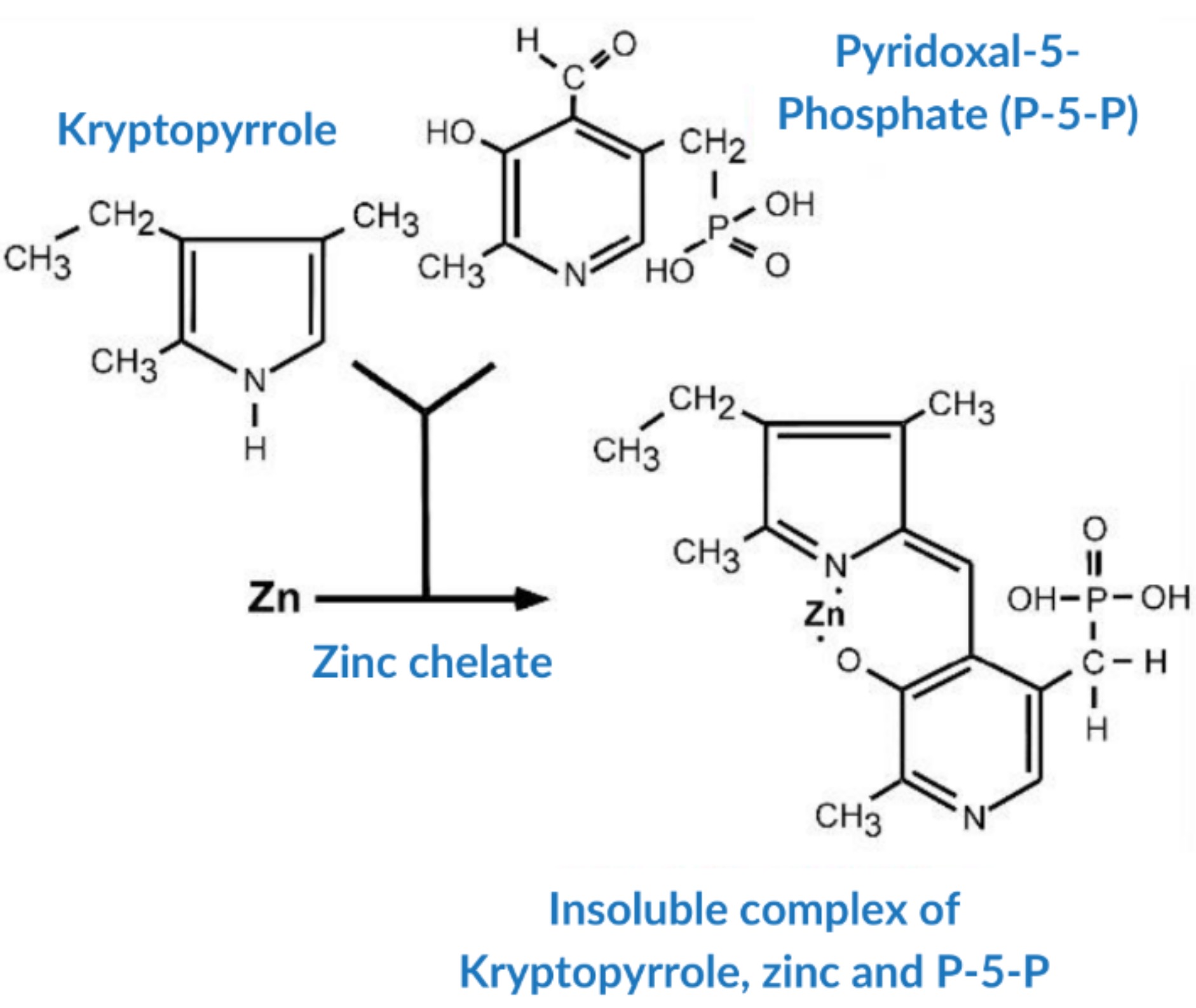Kryptopyrroluria Testing

Kryptopyrroluria (KPU) is a metabolic disorder characterised by a disorder in the breakdown of heme that leads to the excessive excretion of pyrroles in the urine. Pyrroles are a group of chemical compounds derived from the breakdown of heme, a component of haemoglobin. As a result, important nutrients such as vitamin B6 (pyridoxine), zinc and manganese become bound to the pyrroles and are lost through the urine. This can lead to deficiencies of these essential nutrients and disrupt various metabolic processes in the body.

This condition is still relatively unknown in the UK, despite its importance. Its discovery was back in the early 1960s, when Drs. Abram Hoffer, Donald Irvine and Carl C. Pfeiffer detected a compound in the urine of psychiatric patients which Hoffer termed the “Mauve factor” due to its appearance on the chromatograms used in its analysis. Dr. Pfeiffer found that around 30% of patients labelled schizophrenic were suffering from an excess of this mauve factor in their urine, also termed Kryptopyrroles, and that targeted support of their broken metabolic pathways could relieve the condition – often very fast. This metabolic disorder was found to be an underlying factor in a vast range of conditions, from M.E., fibromyalgia and multiple chemical sensitivity to thyroid disorders, ADHD, depression and epilepsy.
Please see this article and the references at the bottom of the page for details of the symptoms of KPU and an overview of its therapy.
AONM now has a test of Kryptopyrroluria conducted via a highly reputed laboratory in Germany. This is performed via urine sample – the collection is very simple, AONM provides a kit and full instructions. It will soon be possible to carry out this test via dry urine spot, too – validation is currently underway.
The KPU test measures total pyrrole compounds in the urine from a mid-stream random sample: please see an example of a report here.
Symptoms of KPU
__________________________________________________________________
- Physical appearance: Pale, sallow skin, pale lips, pruritis either in certain areas or all over (anal pruritis is particularly prevalent in children); light intolerance, rash in sunlight, yellowish-brown pigmentation after being in the sun, slight puffiness of the face, especially around the cheeks and eyes. Dark rings around the eyes, eyes sunk deep into their sockets; soft gums; striae on the skin similar to stretch marks; white spots on the nails (leukodynia), sometimes hair loss, acne, eczema and dandruff; poor tooth enamel
- Neurological issues, often labelled psychiatric: Memory and concentration difficulties, problems with short-term memory, “brain fogâ€, poor dream recall, low mood, fear, panic attacks, withdrawal from social activities, hallucinations, apparent schizophrenia/psychosis, ADHD
- Impaired energy production: Fatigue, may be severe
- Detoxification issues, resulting in intolerance to medications and chemicals (MCS)
- Thyroid disorders: Hypothyroidism, Hashimoto’s thyroiditis
- Immune disorders, particularly bronchial infections, cystitis and urinary infections, sinusitis particularly in children
- Musculoskeletal symptoms: Hypermobility, pelvic instability, weak muscles. Often muscle and joint pain (due to myoglobin being affected, because it has a haem group)
- Allergies, food intolerances, lactose intolerance (lactoperoxidase contains haem)
- Gynaecological issues: Menstrual disorders, fertility issues, complications in pregnancy
- Gastrointestinal disorders: Bloating, pain, nausea, especially in the morning. Alternating diahorrea and constipation, halitosis, aversion to meat (because the conversion of muscle protein to our own protein is B6-dependent)
- Blood sugar disorders: Hypoglycaemia (because gluconeogenesis is B6-dependent); diabetes type II
- Methylation issues, hyperhomocysteinaemia
Source: Joachim Strienz, Leben mit KPU Kryptopyrrolurie (Living with KPU – Kryptopyrroluria, only available in German)
__________________________________________________________________
Please contact AONM with any further questions at support@aonm.org or via our helpline on +44 (0) 3331 210 305 (09:00—17:00 Monday to Friday).
References
Rainforest J et al. Clinical significance and importance of elevated urinary kryptopyrroles (UKP): self-reported observations and experience of Australian clinicians using UKP testing. Adv Integr Med 2021; 8 (3): 159 – 166
Sherwin A, Shaw IC. Sixty years of conjecture over a urinary biomarker: a step closer to understanding the proposed link between anxiety and urinary pyrroles. Lab Med. 2023 Sep 12:lmad086.
Lambert B, Semmler A, Beer C, Voisey J. Pyrroles as a Potential Biomarker for Oxidative Stress Disorders. Int J Mol Sci. 2023 Feb 1;24(3):2712.
Mikirova, Nina. (2015). Clinical Test of Pyrroles in Psychiatric Disorders: Association with Nutritional, Immunological and Metabolic Markers. Journal of Nutritional Therapeutics. 4. 4-11. 10.6000/1929-5634.2015.04.01.2.
Forsgren, S. (2009). Kryptopyrroluria (aka Hemopyrrollactamuria): A Major Piece of the Puzzle in Overcoming Chronic Lyme Disease. Explore 18 (6).
Gilian Crowther MA (Oxon), ND/NT, FBANT, mNNA, CNHC reg, AONM©. (2015). AONM Cell Symbiosis Therapy (CST) Series Kryptopyrroluria – The Elephant in the Room. Academy of Nutritional Medicine (AONM).
Hoffmann, K., & Kauffmann, S. (2013). ADHS/ADS – Kryptopyrrolurie als oft verkannte Ursache. Symptome.Ch. https://www.symptome.ch/blog/ads-adhs-ursache-kpu/
Hoffmann, K., & Kauffmann, S. (2014). KPU, Kryptopyrrolurie: Eine häufige, aber vergessene Stoffwechselstörung. Hachinger Verlagsgesellschaft.
Kryptopyrrolurie – die nicht beachtete Krankheit. (n.d.). Kpu-berlin.de. Retrieved 30 November 2023, from https://www.kpu-berlin.de/
Strienz, J. (2010). Leben mit KPU – Kryptopyrrolurie. W. Zuckschwerdt Verlag.
